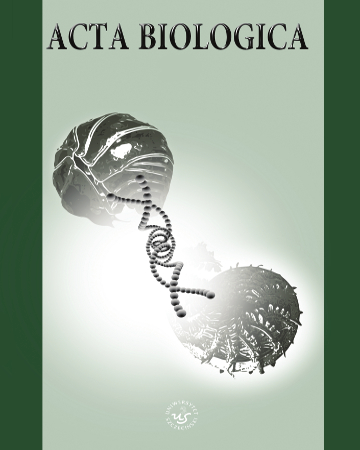
ISSN: 2450-8330
OAI
DOI: 10.18276/ab.2017.24-06



Issue archive /
No. 24
QS – systems communication of Gram-positive bacterial cells
| Authors: |
Alicja
Ziemichód
University of Szczecin, Department of Genetics, Faculty of Biology Bogumiła Skotarczak University of Szczecin, Department of Genetics, Faculty of Biology |
| Keywords: | Quorum sensing Gram-positive bacteria signaling molecules gene expression competence of Streptococcus pneumoniae and Bacillus subtilis virulence of Staphylococcus aureus |
| Data publikacji całości: | 2017 |
| Page range: | 6 (51-56) |
Abstract
In Gram-positive bacteria, cell-to-cell communication, also called quorum sensing (QS) mainly
is dependent on extracellular signaling oligopeptide pheromones, which stimulate a response
either indirectly, by activating a two-component phosphorelay, or directly, by binding to
cytoplasmic effectors. The oligopeptide pheromones production and secretion are initiated in
response to specific environmental stimuli or stresses. These pheromones are biosynthesized
through different pathways and some have unusual functional chemistry as a result of posttranslational
modifications. In the cells of Bacillus subtilis and Streptococcus pneumoniae this
system controls the acquisition of the state of competence, while in Staphylococcus aureus it
regulates virulence. The review aims at giving an updated overview of these peptide-dependant
communication pathways.
Download file
Article file
Bibliography
| 1. | Aggarwal, C., Jimenez, J.C., Lee, H., Chlipala, G.E., Ratia, K., Federle, M.J. (2015). Identification of quorum-sensing inhibitors disrupting signaling between Rgg and short hydrophobic peptides in Streptococci. MBio, 3 (6), e00393–15. |
| 2. | Cheung, G.Y., Wang, R., Khan, B.A., Sturdevant, D.E., Otto, M. (2011). Role of the accessory gene regulator agr in community-associated methicillin-resistant Staphylococcus aureus pathogenesis. Infection and Immunity, 79, 1927–1935. |
| 3. | Cook, L.C., Federle, M.J. (2014). Peptide pheromone signaling in Streptococcus and Enterococcus. FEMS Microbiology Reviews, 3 (38), 473–492. |
| 4. | Gordon, R.J., Lowy, F.D. (2008). Pathogenesis of methicillin-resistant Staphylococcus aureus infection. Clinical Infectious Diseases, 46, S350–S359. |
| 5. | Jaworski, A., Serwecińska, L., Stączek, P. (2005). Quorum sensing – bacterial cell-to-cell communication using chemical signal molecules. Advances in Cell Biology, 32, 231–256 (in Polish). |
| 6. | Jimenez, J.C., Federle, M.J. (2014). Quorum sensing in group A Streptococcus. Frontiers in Cellular and Infection Microbiology, 4, 127. |
| 7. | Kleerebezem, M., Quadri, L.E., Kuipers, O.P., De Vos, W.M. (1997). Quorum sensing by peptide pheromones and two-component signal-transduction systems in Gram-positive bacteria. Molecular Microbiology, 24, 895–904. |
| 8. | Lee, M.S., Morrison, D.A. (1999). Identification of a new regulator in Streptococcus pneumoniae linking quorum sensing to competence for genetic transformation. Journal of Bacteriology, 181, 5004–5016. |
| 9. | Li, Y.H., Tian, X. (2012). Quorum sensing and bacterial social interactions in biofilms. Sensors, 12, 2519– 2538. |
| 10. | Lorenz, M.G., Wackernagel, W. (1994). Bacterial gene transfer by natural genetic transformation in the environment. Microbiological Reviews, 58, 563–602. |
| 11. | Lowy, F.D. (2003). Antimicrobial resistance: the example of Staphylococcus aureus. Journal of Clinical Investigations, 111, 1265–1273. |
| 12. | Miller, M.B, Bassler, B.L. (2001). Quorum sensing in bacteria. Annual Review of Microbiology, 55, 165– 199. |
| 13. | Monnet, V., Juillard, V., Gardan, R. (2016). Peptide conversations in Gram-positive bacteria. Critical Reviews in Microbiology, 3 (42), 339–351. |
| 14. | Painter, K.L., Krishna, A., Wigneshweraraj, S., Edwards, A.M. (2014). What role does the quorum sensing accessory gene regulator system play during Staphylococcus aureus bacteremia? Trends in Microbiology, 22, 676–685. |
| 15. | Papenfort, K. Bassler, B.L. (2016). Quorum sensing signal – response systems in Gram-negative bacteria. Nature Reviews Microbiology, 14, 576–588. |
| 16. | Paulander, W., Nissen Varming, A., Bæk, K.T., Haaber, J., Fress, D., Ingmer, H. (2013). Antibiotic-mediated selection of quorum-sensing-negative Staphylococcus aureus. MBio, 3, e00459–12. |
| 17. | Siepka, M., Gładkowski, W. (2012). The phenomenon of quorum sensing. Creative Science – Monograph, 3, 172–181 (in Polish). |
| 18. | Solomon, J.M., Lazazzera, B.A., Grossman, A.D. (1996). Purification and characterization of an extracellular peptide factor that affects two different developmental pathways in Bacillus subtilis. Genes & Development, 10, 2014–2024. |
| 19. | Vijayalakshmi, M. (2013). Quorum Sensing in Gram-negative and Gram-positive bacterial systems. NPTEL-Biotechnology-Systems Biology. Joint Initiative of IITs and IISc– Funded by MHRD. |
| 20. | Wolska, K.I. (2012). Bacterial transformation. In: J. Baj, Z. Markiewicz (eds.), Biologia molekularna bakterii (pp. 440–444). Warszawa: Wydawnictwo Naukowe PWN (in Polish). |